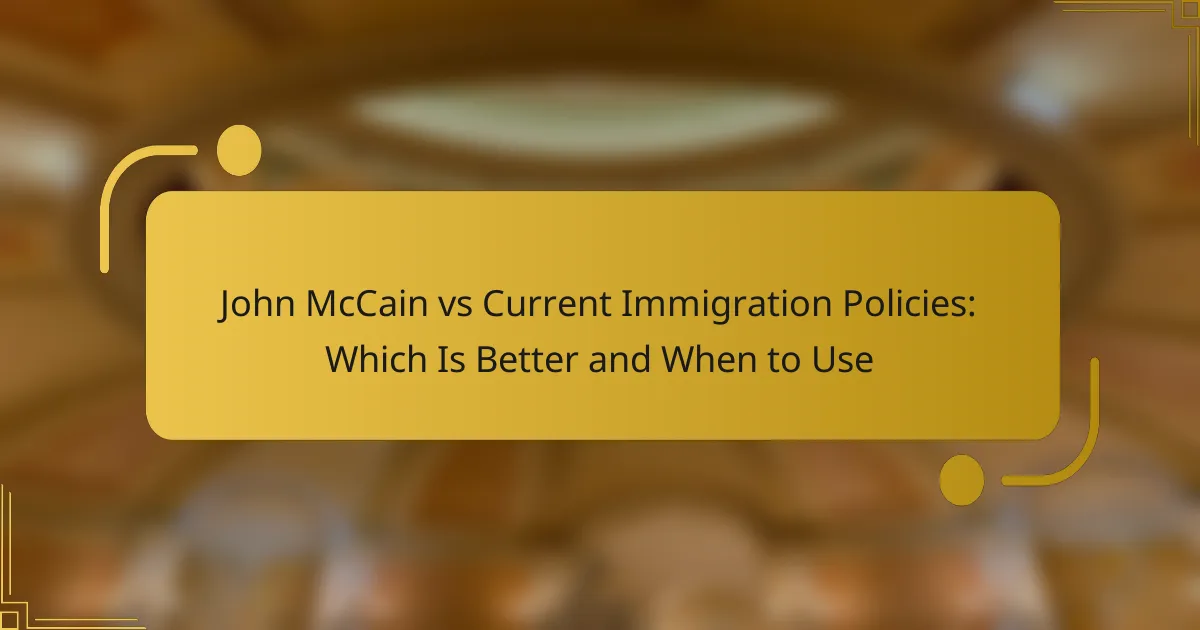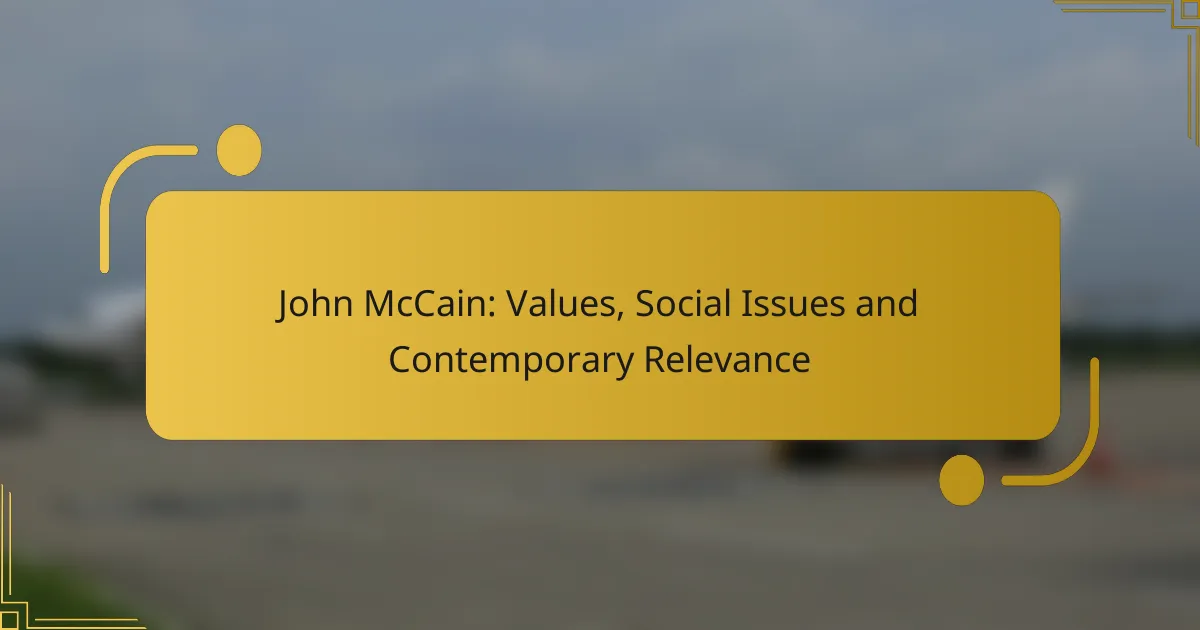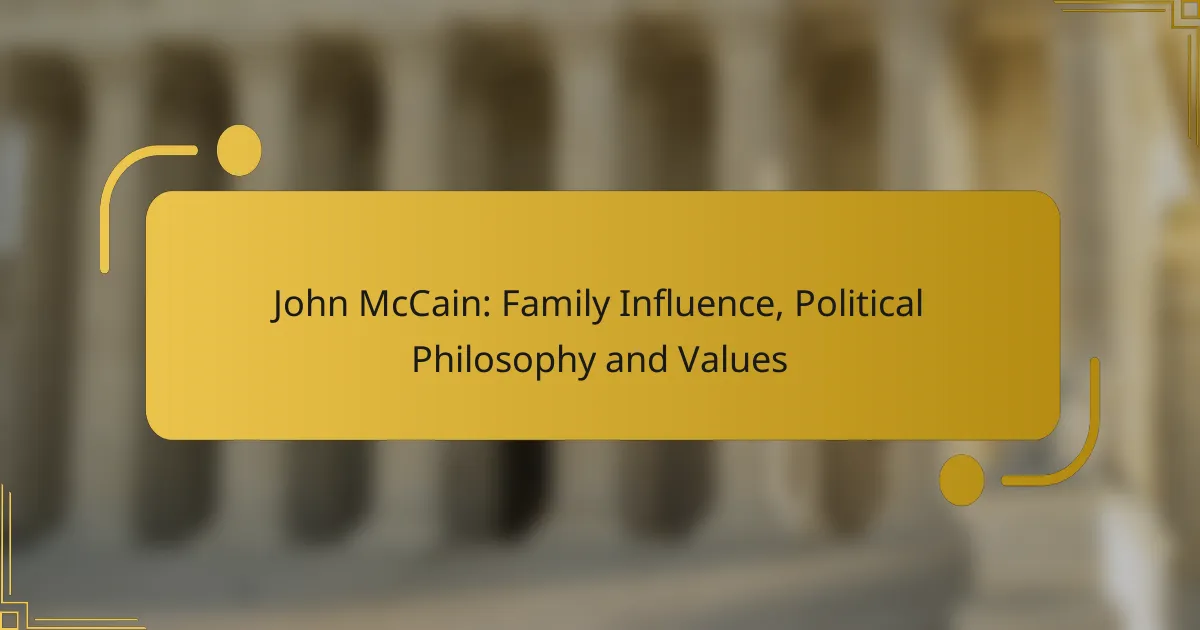John McCain’s immigration policies advocated for comprehensive reform that included a pathway to citizenship and bipartisan collaboration, contrasting sharply with current approaches that emphasize strict border security and enforcement. This evolution in immigration policy reflects the shifting political landscape and public attitudes towards immigration in the United States. McCain’s framework is particularly relevant in contexts requiring a balanced solution that addresses both security concerns and the humanitarian needs of undocumented immigrants.
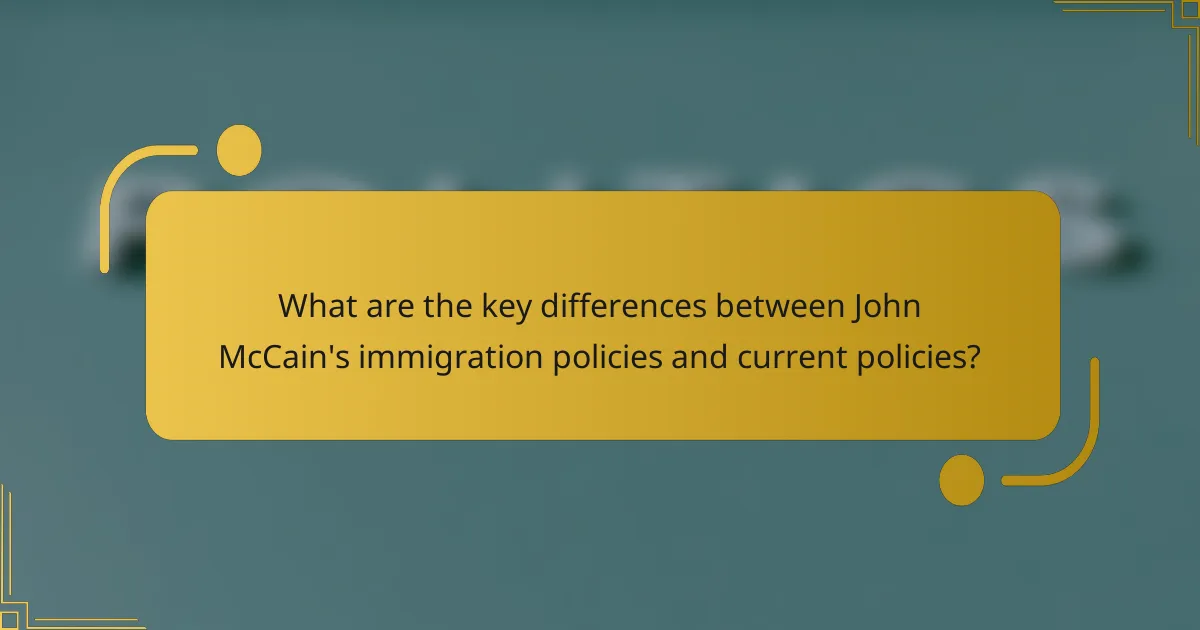
What are the key differences between John McCain’s immigration policies and current policies?
John McCain’s immigration policies focused on comprehensive reform, emphasizing a pathway to citizenship and bipartisan cooperation, while current policies tend to prioritize border security and stricter enforcement measures. The shift reflects changing political climates and public sentiment regarding immigration in the United States.
McCain’s Comprehensive Immigration Reform
John McCain advocated for a comprehensive immigration reform that included a pathway to citizenship for undocumented immigrants, contingent on background checks and learning English. His approach aimed to balance border security with humane treatment of immigrants, seeking bipartisan support to address the complexities of immigration.
McCain’s proposals often included provisions for temporary worker programs to meet labor shortages, recognizing the economic contributions of immigrants. This holistic view contrasted with more fragmented approaches that focus solely on enforcement.
Current Administration’s Immigration Approach
The current administration’s immigration policies emphasize strict border security and enforcement, often prioritizing the deportation of undocumented immigrants. This approach reflects a shift towards a more hardline stance, with significant resources allocated to border patrol and immigration enforcement agencies.
Current policies have also introduced measures such as the “Remain in Mexico” program, which requires asylum seekers to wait outside the U.S. while their claims are processed, highlighting a focus on limiting immigration rather than reforming the system.
Impact on Border Security
McCain’s policies included provisions for enhanced border security but did not prioritize it above the need for reform. He believed that securing the border should be part of a comprehensive solution that also addressed the status of undocumented immigrants.
In contrast, current policies have significantly increased funding for border security measures, including physical barriers and surveillance technology, reflecting a more militarized approach to immigration control. This focus aims to deter illegal crossings and enhance national security.
Pathway to Citizenship Variations
Under McCain’s vision, the pathway to citizenship was designed to be accessible, requiring undocumented immigrants to meet specific criteria over time, such as paying taxes and learning English. This approach aimed to integrate immigrants into society while maintaining legal standards.
Current policies, however, have largely eliminated pathways to citizenship for many undocumented immigrants, focusing instead on temporary status or deportation. This shift has left millions without a clear route to legal residency, creating uncertainty and fear within immigrant communities.
Deportation Policies Comparison
McCain’s immigration stance was more lenient regarding deportation, advocating for a focus on serious criminals rather than non-violent undocumented immigrants. He believed in prioritizing resources for those who posed a genuine threat to society.
In contrast, current policies have expanded deportation efforts to include a broader range of undocumented individuals, often leading to increased family separations and community distress. This change reflects a significant shift in the approach to immigration enforcement, prioritizing strict adherence to immigration laws over humanitarian considerations.
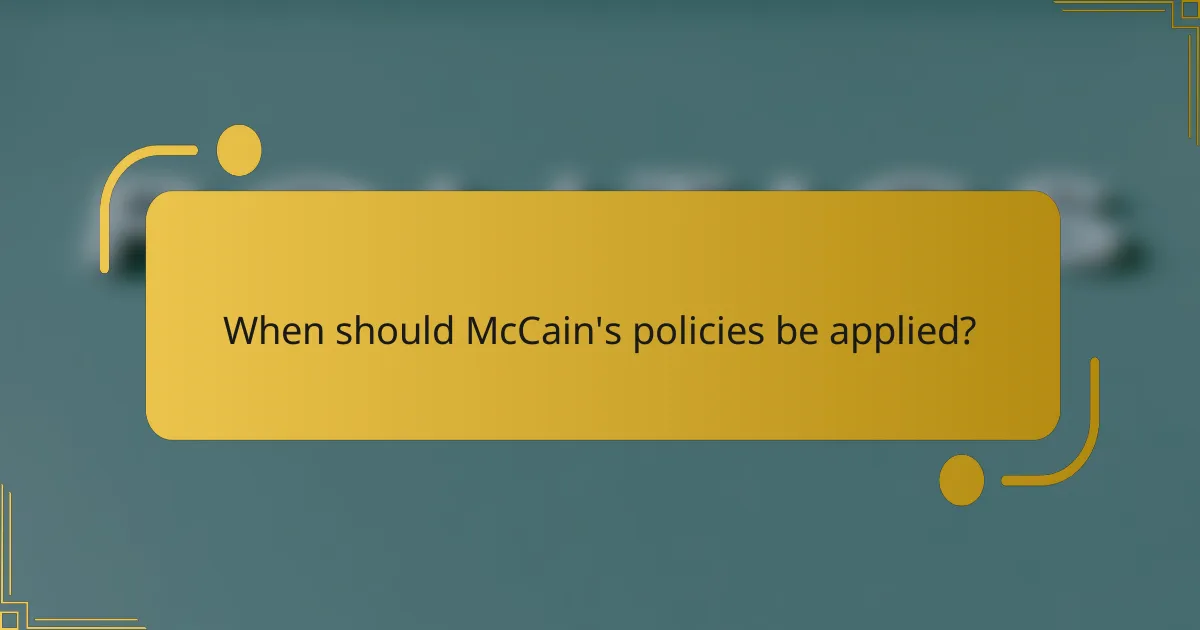
When should McCain’s policies be applied?
McCain’s immigration policies should be applied in situations where comprehensive reform is necessary to address systemic issues in the immigration system. These policies are particularly relevant when seeking to balance border security with pathways to citizenship for undocumented immigrants.
Historical Context of McCain’s Policies
John McCain was a proponent of comprehensive immigration reform, advocating for a balanced approach that included both enhanced border security and a pathway to citizenship for undocumented immigrants. His bipartisan efforts in the early 2000s aimed to address the growing challenges of immigration while recognizing the contributions of immigrants to the economy.
McCain’s policies reflected a time when immigration was viewed as a complex issue requiring cooperation across party lines. His willingness to engage with both sides of the aisle set a precedent for future discussions on immigration reform.
Situations Favoring Comprehensive Reform
Comprehensive reform is favored in scenarios where there is a significant population of undocumented immigrants contributing to the economy. For instance, when labor shortages occur in sectors like agriculture or technology, pathways to legal status can help fill these gaps while ensuring that workers are protected under labor laws.
Additionally, comprehensive reform is beneficial during economic downturns when addressing the status of undocumented immigrants can lead to increased tax revenues and a more stable workforce. Policymakers should consider public sentiment and economic conditions when advocating for such reforms.
Current Political Climate Considerations
The current political climate is often polarized, making it challenging to implement McCain’s comprehensive policies. However, there are moments of bipartisan agreement, especially when addressing urgent issues like workforce shortages or humanitarian crises at the border.
Advocates for McCain’s approach should focus on building coalitions that emphasize shared economic interests and public safety. Engaging local communities and stakeholders can help create a supportive environment for reform efforts, making it easier to navigate the political landscape.
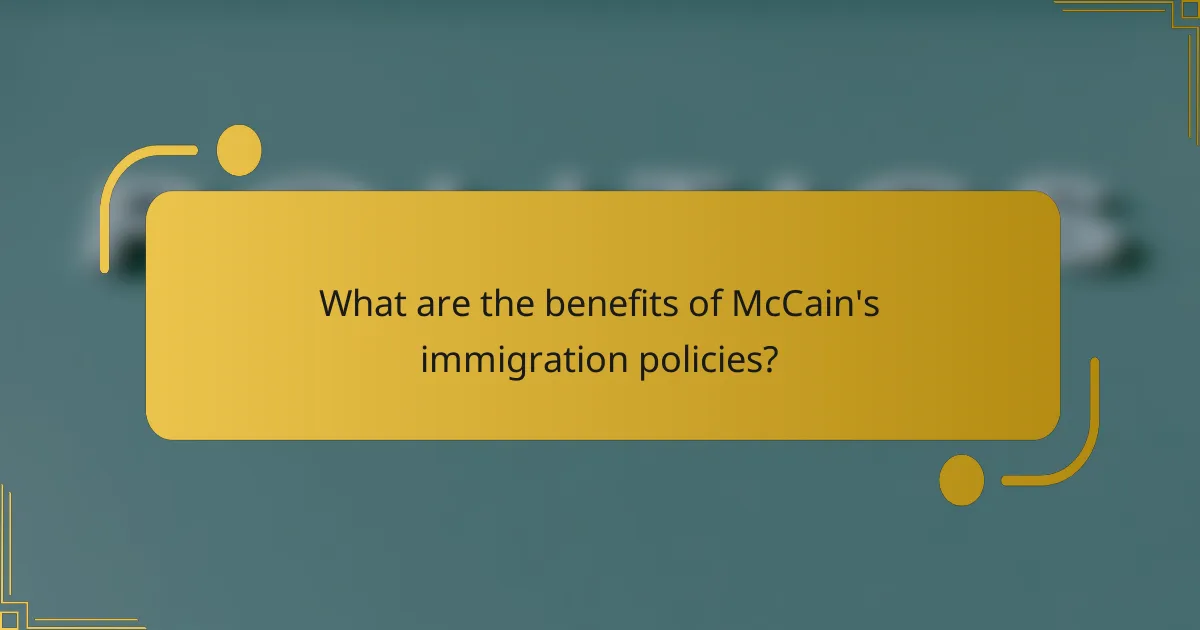
What are the benefits of McCain’s immigration policies?
McCain’s immigration policies aimed to create a balanced approach that addressed economic needs while respecting humanitarian concerns. His proposals included pathways to citizenship for undocumented immigrants, which could enhance both the economy and social cohesion.
Economic Growth Potential
McCain’s immigration policies recognized the significant role that immigrants play in driving economic growth. By providing pathways to legal status, these policies could increase the labor force, particularly in sectors facing shortages, such as agriculture and technology.
Increased legal immigration can lead to higher consumer spending, as newly legalized individuals often contribute to local economies. For example, studies suggest that comprehensive immigration reform could boost GDP by hundreds of billions over a decade.
Humanitarian Aspects
McCain’s approach emphasized the importance of treating immigrants with dignity and respect, acknowledging their contributions to society. His policies sought to provide a humane solution for those who had built lives in the U.S. despite their undocumented status.
By allowing undocumented immigrants to apply for citizenship, McCain’s policies aimed to reunite families and provide stability to communities. This approach not only benefits individuals but also fosters a more inclusive society.
Long-term Stability in Immigration
McCain’s immigration policies proposed a structured system that could lead to long-term stability in immigration. By establishing clear pathways for legal residency, these policies could reduce the uncertainty faced by many immigrants.
A stable immigration system can help prevent the rise of undocumented populations, as individuals would have a legal route to residency. This predictability can enhance national security and allow for better resource allocation in immigration enforcement.
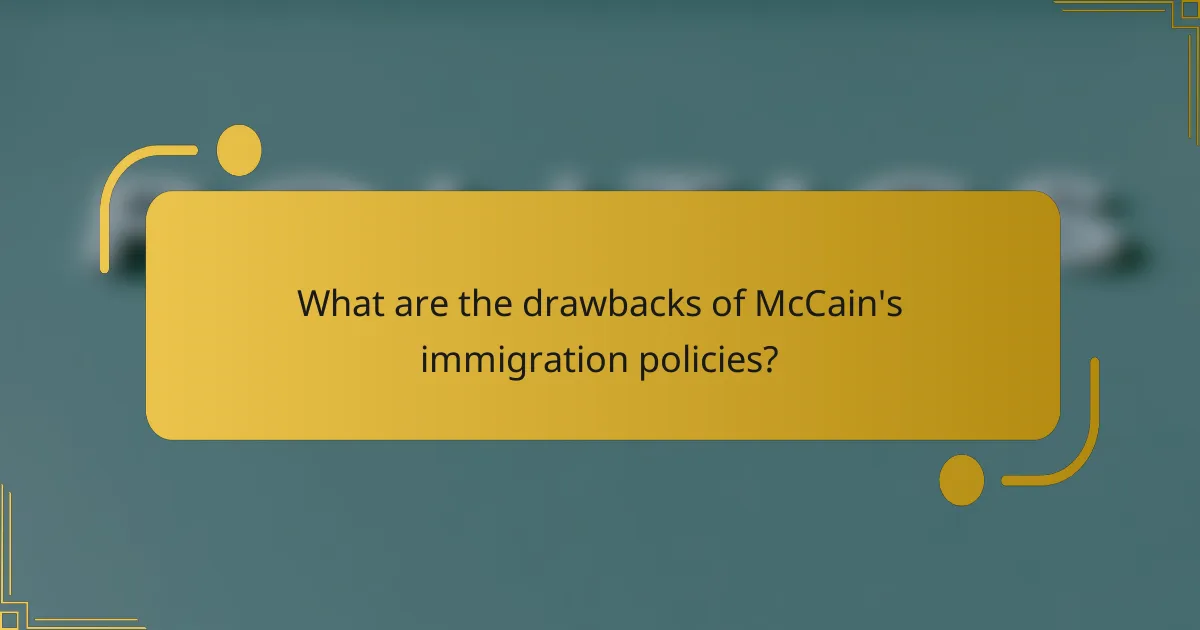
What are the drawbacks of McCain’s immigration policies?
McCain’s immigration policies faced several drawbacks, including political feasibility challenges, public resistance, and implementation complexities. These factors hindered the effectiveness and acceptance of his proposed reforms.
Political Feasibility Challenges
One significant drawback of McCain’s immigration policies was their political feasibility. Efforts to pass comprehensive immigration reform often faced opposition from various political factions, making it difficult to achieve bipartisan support. This lack of consensus limited the potential for successful implementation.
Additionally, the shifting political landscape and changing priorities within Congress can derail immigration initiatives. For instance, proposals that seemed viable at one point may become politically toxic as public sentiment evolves or as elections approach.
Public Opinion and Resistance
Public opinion played a crucial role in shaping the reception of McCain’s immigration policies. Many Americans expressed concerns about border security and the perceived impact of immigration on jobs and social services. These fears fueled resistance to reforms that aimed to provide pathways to citizenship for undocumented immigrants.
Moreover, grassroots movements and advocacy groups often mobilized against comprehensive reform, emphasizing the need for stricter enforcement rather than a pathway to legal status. This public resistance complicated efforts to garner support for McCain’s proposals.
Implementation Complexity
The complexity of implementing McCain’s immigration policies was another significant drawback. Comprehensive reforms often require coordination among various federal, state, and local agencies, which can lead to bureaucratic delays and inefficiencies. For example, establishing a new system for tracking undocumented immigrants or processing citizenship applications can be logistically challenging.
Furthermore, the need for adequate funding and resources to support these initiatives can create additional hurdles. Without sufficient investment in infrastructure and personnel, even well-intentioned policies may struggle to achieve their intended outcomes.
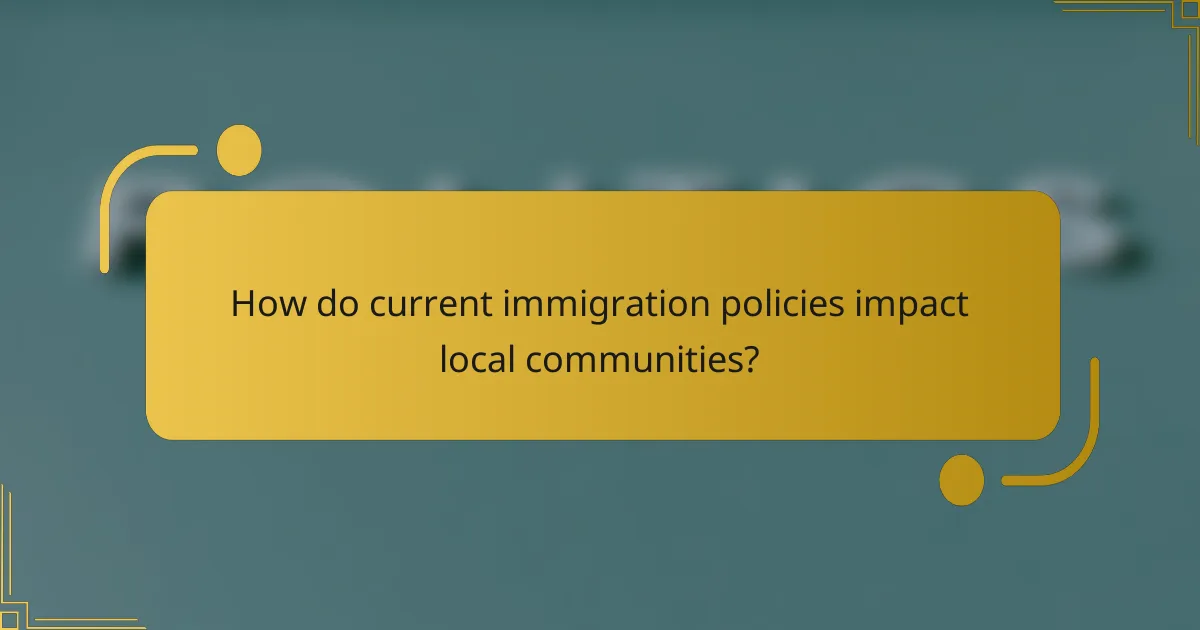
How do current immigration policies impact local communities?
Current immigration policies significantly influence local communities by shaping demographic trends, economic opportunities, and social dynamics. These policies can either foster integration and growth or create challenges that affect community cohesion and safety.
Effects on Workforce Dynamics
Immigration policies directly affect workforce dynamics by influencing the availability of labor in various sectors. For instance, industries such as agriculture, hospitality, and construction often rely on immigrant workers to fill low-skilled positions. When policies are restrictive, these sectors may face labor shortages, leading to increased costs and reduced productivity.
Conversely, more inclusive immigration policies can enhance workforce diversity and innovation. A diverse workforce brings different perspectives and skills, which can drive economic growth and improve competitiveness in local markets.
Community Integration Challenges
Current immigration policies can create significant integration challenges for newcomers and their families. When policies are overly stringent, immigrants may struggle to access essential services such as education, healthcare, and legal assistance, hindering their ability to integrate into the community.
Moreover, language barriers and cultural differences can exacerbate these challenges, making it difficult for immigrants to connect with local residents. Communities that prioritize inclusive policies often implement programs to facilitate integration, such as language classes and cultural exchange initiatives.
Local Law Enforcement Implications
Local law enforcement agencies are often impacted by immigration policies, particularly regarding community trust and cooperation. Strict immigration enforcement can lead to fear among immigrant populations, causing them to avoid reporting crimes or seeking help from authorities. This lack of cooperation can undermine public safety and hinder effective policing.
On the other hand, policies that promote community policing and trust-building can enhance cooperation between law enforcement and immigrant communities. Programs that focus on protecting the rights of all residents, regardless of immigration status, can foster a safer environment for everyone.
